Christopher Goulding
The Real Dr Frankenstein?
Mary Shelley’s novel Frankenstein has become one of the most analysed literary texts of the modern age. Its central theme provides a metaphor conducive to almost limitless reinterpretation, drawn by different readings into the service of numerous ideologies including Marxist economics, radical feminism, green politics, and most recently, genetics and biotechnology.
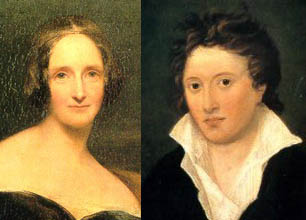 As the author’s concerns clearly lie with the moral and sociological implications of her story, attempts to identify likely origins for the scientific elements have attracted less attention, and generally refer only to the most contemporaneous sources easily available to the educated dilettante public. Nevertheless, doubts exist concerning Mary Shelley’s degree of specific interest in, or knowledge of, scientific subjects. Accordingly, the level of influence exerted in this field by her husband, the poet Percy Bysshe Shelley, also remains open to debate. He maintained a keen interest in the world of natural philosophy, and many critics have noted the significance of the references to ‘Dr (Erasmus) Darwin and some of the physiological writers of Germany’ in the novel’s Preface, which was written by him. But a closer examination of the medical themes running throughout the novel strongly suggests a more obscure influence at work, arising from Percy Shelley’s friendship with a Scots doctor whilst he was still a schoolboy at Eton.
As the author’s concerns clearly lie with the moral and sociological implications of her story, attempts to identify likely origins for the scientific elements have attracted less attention, and generally refer only to the most contemporaneous sources easily available to the educated dilettante public. Nevertheless, doubts exist concerning Mary Shelley’s degree of specific interest in, or knowledge of, scientific subjects. Accordingly, the level of influence exerted in this field by her husband, the poet Percy Bysshe Shelley, also remains open to debate. He maintained a keen interest in the world of natural philosophy, and many critics have noted the significance of the references to ‘Dr (Erasmus) Darwin and some of the physiological writers of Germany’ in the novel’s Preface, which was written by him. But a closer examination of the medical themes running throughout the novel strongly suggests a more obscure influence at work, arising from Percy Shelley’s friendship with a Scots doctor whilst he was still a schoolboy at Eton.
During his last two years at Eton in 1809-1810, Percy Shelley became the friend of an elderly gentleman who was one of a number of persons approved by the school as suitable mentors for the boys. Dr James Lind MD FRS (1736 -1812) was a widower living in semi-retirement at nearby Windsor. Born and educated in Edinburgh, he had travelled extensively as a ship’s surgeon to Africa, India, and China. Lind (not to be confused with his cousin of the same name, who was author of A Treatise on the Scurvy) was also an accomplished astronomer and geologist and had accompanied Sir Joseph Banks of the Royal Society on a scientific expedition to Iceland in 1772. To polite society in Windsor, Lind appeared something of an eccentric. This image was later confirmed by his son Alexander, who vividly evoked the alchemic appearance of his father’s study in the family home: ‘There were telescopes, Galvanic Batteries, Daggers, Electrical Machines, and all the diverse apparatus which a philosopher is supposed to possess.’
Lind was, in fact, a highly knowledgeable natural philosopher with a keen interest in the latest developments in every emerging field of science, which were also to attract the young poet Shelley. He was a friend, acquaintance, or correspondent of most of the great names of eighteenth century science, philosophy and technology, including Benjamin Franklin, William Herschel, David Hume, Adam Smith and James Watt. In Mary Shelley’s uncompleted and fragmentary posthumous biography of her husband, she stated that at Eton he:
…became intimate also with a man whom he never mentioned except in terms of the tenderest respect. This was Dr Lind, a name well known among the professors of medical science… he has often said… ‘I owe that man far – oh! Far more than I owe my father.’
Shelley’s friend Thomas Jefferson Hogg noted that Lind ‘communicated to Shelley a taste for chemistry and chemical experiments.’ Hogg also remarked that in Shelley’s rooms at Oxford there was a confusion of clutter: ‘… An electrical machine, an air pump, the galvanic trough, a solar microscope, and… a small glass retort above an argand lamp.’
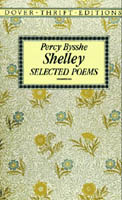 Percy Shelley later immortalised Lind in verse as the character Zonoras, the wise old teacher of Prince Athanase in the poem that takes his name:
Percy Shelley later immortalised Lind in verse as the character Zonoras, the wise old teacher of Prince Athanase in the poem that takes his name:
Prince Athanase had one beloved friend
An old, old man, with hair of silver white
And lips where heavenly smiles would hang and blend
With his wise words; and eyes whose arrowy light
Shone like the reflex of a thousand minds.
Mary Shelley evidently shared her husband’s abiding interest in advances in medicine and enjoyed the stimulation of scientific speculation. Before meeting her, inspired by Lind, Percy had read such medical works as Thomas Trotter’s A View of the Nervous Temperament (1812), and was familiar with the extensively annotated scientific poetry expounding the observations, theories, and predictions of the physician and natural philosopher Erasmus Darwin. Recent editors of Frankenstein have noted that Percy Shelley could have been aware of ‘the physiological writers of Germany’ via his personal physician William Lawrence, who had translated Blumenbach’s Comparative Anatomy in 1807.
Mary Shelley’s journals painstakingly (though by no means exhaustively) itemise her husband’s systematic reading programme from the date of their elopement in 1814. She also records an outing with him in London on 28 December that year to see a public lecture on galvanism and the medicinal uses of electricity by André-Jacques Garnerin. (Percy went again the following evening with a friend, but found the lecture hall closed.)
Recent biography of Mary Shelley has suggested closer links between the author herself and the purely medical aspects of her novel. These include her possible reading in 1814 of accounts of the restoration to consciousness of a sailor who had lain in a coma for several months, by Dr Henry Cline, whose patient Mary had once been. Also cited is an entry in Mary’s journal for 19 March 1815, shortly after the death of her first baby: ‘Dreamt that my little baby came to life again – that it had only been cold & that we rubbed it by the fire and it lived.’ Another link is that between Mary’s father, William Godwin, and Luigi Galvani, via a review in March 1800 by two of Godwin’s friends, the physicist William Nicholson and the surgeon Anthony Carlisle, of a paper by Volta, who had previously challenged Galvani’s theories of ‘animal electricity.’
Mary Shelley was eighteen years old when she began Frankenstein in the summer of 1816, while a guest at Lord Byron’s Villa Diodati on the shores of Lake Geneva. Some detail of the novel’s origins emerges in her Introduction to the revised single-volume edition of 1831, where she describes how she was the ‘silent listener’ to the long philosophical discussions between her husband and Lord Byron:
They talked of the experiments of Dr Darwin… who preserved a piece of vermicelli in a glass case till by some extraordinary means it began to move with a voluntary motion. Not thus, after all, would life be given. Perhaps a corpse would be reanimated; galvanism had given token of such things: perhaps the component parts of a creature might be manufactured, brought together, and embued with vital warmth.
She then notes how, inspired by the overheard conversations, her imagination contrived the germ of the story:
I saw the pale student of unhallowed arts kneeling beside the thing he had put together. I saw the hideous phantasm of a man stretched out, and then, on the working of some powerful engine, show signs of life and stir with an uneasy half-vital motion.
In fact, the account in the novel of the creature’s creation by Victor Frankenstein provides only the vaguest detail, culminating in a rather subdued account of its awakening:
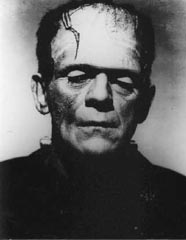 It was on a dreary night of November, that I beheld the accomplishment of my toils. With an anxiety that almost amounted to agony, I collected the instruments of life around me, that I might infuse a spark of being into the lifeless thing that lay at my feet. It was already one in the morning; the rain pattered dismally against the panes, and my candle was nearly burnt out, when by the glimmer of the half-extinguished light, I saw the dull yellow eye of the creature open; it breathed hard, and a convulsive motion agitated its limbs.
It was on a dreary night of November, that I beheld the accomplishment of my toils. With an anxiety that almost amounted to agony, I collected the instruments of life around me, that I might infuse a spark of being into the lifeless thing that lay at my feet. It was already one in the morning; the rain pattered dismally against the panes, and my candle was nearly burnt out, when by the glimmer of the half-extinguished light, I saw the dull yellow eye of the creature open; it breathed hard, and a convulsive motion agitated its limbs.
Certain medical themes and quasi-autobiographical events in Frankenstein suggest the influence of Lind’s character and work, via his pupil Percy Shelley. The description in the novel of Victor Frankenstein’s medical studies at the University of Ingolstadt is an idealised version of Percy Shelley’s scientific education, with the character Waldman, the chemistry lecturer, owing much to Lind. And an examination of Lind’s own experiments reveals that he was even closer to the world of Frankenstein than has hitherto been acknowledged. Between 1782 and 1809, Lind maintained a regular correspondence with the London-based Italian physicist Tiberio Cavallo. Cavallo mentions Galvani’s experiments on 19 June 1792, the year following publication of Galvani’s research. On 11 July he asks Lind, ‘Have you made any dead frogs jump like living ones?’ And then on 15 August he writes, ‘I am glad to hear of your success in the new experiments on muscular motion, and earnestly entreat you to prosecute them to the ne plus ultra of possible means.’
Lind was also a regular correspondent of Sir Joseph Banks, President of the Royal Society. On 28 October 1792 he thanks Banks for supplying frogs that have enabled him to 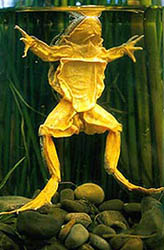 conduct experiments with Cavallo towards ‘the unravelling of that extraordinary and as yet inexplicable phenomenon, Animal Electricity.’ Lind also notes how, the previous week, he had demonstrated such an experiment to the King, Queen, and other members of the royal family. In the same letter, he tells of a visit some five weeks earlier of Dr Valli of Pisa, who spent a day with him demonstrating ‘… a more perfect manner of preparing the frog by which I could employ both Crural nerves at the same time instead of only part of one of them separated from the thigh. The difference was astonishing.’
conduct experiments with Cavallo towards ‘the unravelling of that extraordinary and as yet inexplicable phenomenon, Animal Electricity.’ Lind also notes how, the previous week, he had demonstrated such an experiment to the King, Queen, and other members of the royal family. In the same letter, he tells of a visit some five weeks earlier of Dr Valli of Pisa, who spent a day with him demonstrating ‘… a more perfect manner of preparing the frog by which I could employ both Crural nerves at the same time instead of only part of one of them separated from the thigh. The difference was astonishing.’
He then mentions a letter Cavallo had received from Volta, contesting Galvani’s theories. In another letter to Banks dated 27 November 1788, written during one of the King’s periods of ‘insanity’, Lind discusses the possibility of treatment by the application of electricity:
If we may credit the accounts of the state of the Brain of insane persons found upon dissection, I think there is great reason to believe that it may be of service in that disorder and appears to me to merit a fair tryal.
Running alongside Frankenstein‘s central plot concerning the creation of a monster, parallel themes address contemporary perceptions of the increasingly blurred boundary between life and death. These include an early excerpt where Victor Frankenstein is dragged freezing and emaciated aboard a ship from an ice floe in the Arctic Ocean:
We accordingly brought him back to the deck, and restored him to animation by rubbing him with brandy, and forcing him to swallow a small quantity. As soon as he showed signs of life, we wrapped him up in blankets…
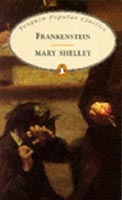 Later, the creature attempts to resuscitate a young girl whose body he has dragged from a river: ‘She was senseless; and I endeavoured, by every means in my power, to restore animation…’ Such references recall Lind’s own medical education in Edinburgh under William Cullen, who was instrumental in the early codification of procedures for the revival of drowned or otherwise asphyxiated persons.
Later, the creature attempts to resuscitate a young girl whose body he has dragged from a river: ‘She was senseless; and I endeavoured, by every means in my power, to restore animation…’ Such references recall Lind’s own medical education in Edinburgh under William Cullen, who was instrumental in the early codification of procedures for the revival of drowned or otherwise asphyxiated persons.
Cullen is, in fact, mentioned within this context in a medical work known to have been ordered by Percy Shelley from his bookseller in July 1812. Robert Thornton’s Medical Extracts includes a lengthy passage on methods suitable for persons being ‘recalled to life’ from ‘the silent mansions of the tomb’, and mentions the theories of Cullen and Boerhaave on the causes of death from asphyxiation by hanging. Interestingly, Waldman’s assessment in Frankenstein of modern philosophers as the successors to the alchemists bears similarities to comments in Thornton’s book.
Lind’s interest in forensic medicine may be seen as the inspiration for Percy Shelley’s creation of perhaps the earliest example of ratiocinative detective drama in his play The Cenci, and his influence can be found in other of Shelley’s themes. It is also fascinating to consider how his ideas, mediated through Percy Shelley and others, worked on Mary Shelley’s imagination. We can now see Lind as part of the chain of imaginative and intellectual DNA that resulted in this perceptive and prescient novel, whose central figure has taken such a hold on popular consciousness.
‘The Real Doctor Frankenstein?’ first appeared in the Journal of the Royal Society of Medicine, May 2002.
Frankenstein: Or, the Modern Prometheus by Mary Shelley is available in Penguin Popular Classics (ISBN 0140620303, £1.50 PBK). Percy Shelley’s Selected Poems are available in Dover Thrift Edition (ISBN 0486275582 £2.50 PBK).
© Christopher Goulding 2002

Comments